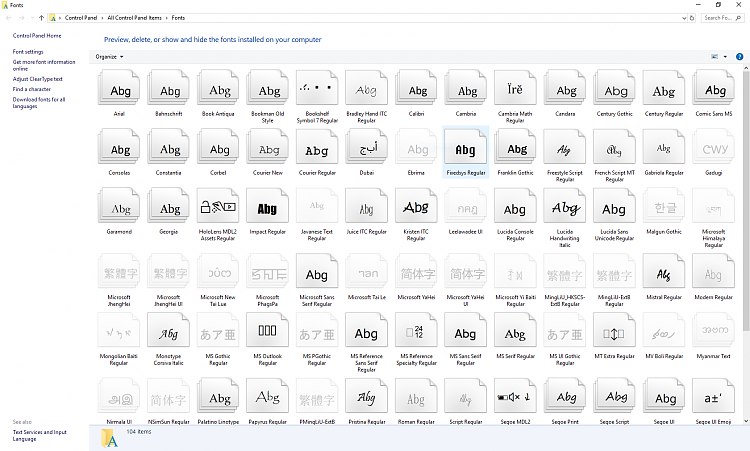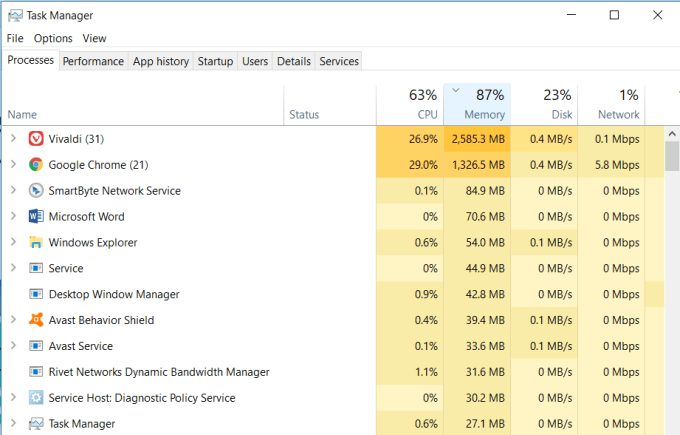Because I’m such a nice guy, I’m going to teach others a simple fix to improve Windows 10’s performance. This is not guaranteed to cure all your Windows 10 problems, but it will help. It consists of resetting virtual memory in Windows 10. And, I’m not even going to explain what virtual memory is, because to do this, you don’t need to know.
Step 1 – Bring up Task Manager (right click on the task bar, and in the popup menu, click on Task Manager). If the Task Manager window looks like this:
How To Clear Cache In Windows 10 from www.wisecleaner.com The project feature in windows 10 offers the following modes: The cache memory of ram is a very small portion of the standard memory of your system, but the cache memory operates at a very high speed, allowing the applications/ programs to utilize its speed to run its users faster. MemPlus will be wont to monitor the RAM usage on your device. You’ll clear the memory of any non-essential processes by clicking the “Clear memory” button that is visible within the main window. This can clear each the operating sets of processes and also the FileSystem cache, if enabled. You furthermore might have the power to clear the.
Click on the More details item to make it look like this:
See that column labeled Disk? If that reads 100%, you now know why your computer is pathetically slow. Hopefully, the remaining steps will fix your computer, so this column reads a much smaller number. If it doesn’t read 100%, you don’t have to do anything, but you can continue with this reset if you wish to.

Step 2 – In the Windows search box (where it says, Type here to search), search for View Advanced System Settings. See that identified application? Click on that. You should now see a window like this one:
Step 3 – In the window area labeled Performance, click on the Settings… button. Now, you should see a window like this one:
Step 4 – In the Performance Options window, click on the Advanced tab. The window should change to look like this:
This is where the fun starts. The area named Virtual Memory shows you how much of your hard disk drive (or solid state drive) is being used by Windows as if it was memory in your computer. If your computer isn’t running well, and your Disk column in Task Manager said 100%, resetting this Virtual Memory should help.
Step 5 – In the Virtual Memory area, click on the Change… button. This will pop up another window that looks like:
Step 6 – Change the Virtual Memory settings by unchecking the Automatically manage paging file size for all drives checkbox, and by clicking on the No paging file radio button. It should look like this:
Step 7 – Click on the Set button. You will see this alert pop up.
Click on Yes. Now, click on the OK button in the Virtual Memory window, then restart your computer.
At this point, you have removed the virtual memory from windows. Your computer WILL run slower. It will take longer to do anything, and everything. Don’t worry. We’re not leaving Windows this way. We’re going to reset virtual memory.
Step 8 – After you are back in Windows, bring up the View Advanced System Settings window again. If you forgot how, see Step 2 above. As before, bring up the Virtual Memory settings (see Step 3 and Step 4). You should be back at this window.
Step 9 – Check the Automatically manage paging file size for all drives check box. And click on the OK button at the bottom of the window. Now, restart your computer one more time.
Step 10 – Repeat Step 1 of this procedure. The Disk column should gradually drop to a much smaller number, and your computer should run better.
For those interested, here’s a brief technical note on what this process does, and why it works.
Windows (XP, Vista, 7, 8, 8.1, and 10) all use a section of your Hard Disk Drive/Solid State Drive, as extra storage space to keep thing in instead of keeping them in RAM all the time. Unfortunately, over time the content of that section of your drive fragments, and then fragments even more. It may even become so fragmented it’s not really usable. Since the virtual memory function of Windows runs all the time, it’s trying to process the content of that drive section all the time. If that content is too fragmented, and even damaged, Windows begins to spend all of its time processing that drive section.
When the Virtual Memory is reset, as described in this procedure, that drive space is first erased, and then a new, clean space is created. This new space does not have the problems the old space had. The result is Windows runs much better, because it doesn’t have to spend all of its time figuring out what’s in that drive space.
Note that I have started resetting virtual memory on my home computer, and on every Windows 10 computer I work on for other people. Because. This works. And it helps the computer run better.
Note: If you try this, you’re on your own. I’m not responsible for anything that may go wrong. I’m just trying to be nice here. If this works for you. Good. If it doesn’t. Well. I tried.
Mark.
The cache memory of RAM is a very small portion of the standard memory of your system, but the cache memory operates at a very high speed, allowing the applications/ programs to utilize its speed to run its users faster. But, sometimes due to memory leak or some bad exe files the amount of free cache memory can decrease, which eventually slows down your computer.
Make your computer automatically clear RAM cache memory-

Follow these easy steps to free cache memory on your system-
1. Download EmptyStandbyList on your computer.
2. Choose a particular place and then click on “Save” to save the application.
Close the browser window.
3. Click on the Search box beside Windows icon and type “Task Scheduler“.
4. Click on “Task Scheduler” from the elevated Search result to open Task Scheduler.
5. In the Task Scheduler window, on the right-hand side, click on “Create Task…“.

6. In Create Task window, name the task “Cache Cleaner“.
7. Now, click on “Create User or Groups…“.
8. Click on “Advanced“.
9. In Select User or Groups window, click on “Find Now“.
10. In the Search results: scroll down and then select “SYSTEM“.

11. Finally, click on “OK” to save the changes.
12. Now, click on “OK” to save the changes.
13. Coming back to Create Task window, checkthe option “Run with highest privileges“.
14. Click on the drop-down beside ‘Configure for:’ and select “Windows 10“.
15. Now, go to the “Triggers” tab.
16. Click on “New…“.

17. In the New Trigger window, under ‘Advanced settings‘ set the ‘Repeat task every:’ to “5 minutes“.
18. And set ‘for a duration of:‘ to “Indefinitely“.
19. In the same window, checkthe option “Enabled“.
20. Click on “OK” to save the trigger settings.
21. Now, go to the “Actions” tab.
22. Then, click on “New…“.
23. In the New Action window, click on “Browse“.
24. Now, navigate to the location where you have downloaded the ‘EmptyStandbyList‘ application.
25. Select the application and then click on “Open“.
26. Now, click on “OK” to save the action.
27. Coming back to the “Create Task” window, click on “OK” to save the task.
28. In the Task Scheduler window, click on “Refresh” to refresh the tasks list.
That’s it! From now on at a regular interval of 5 minutes, this ‘Cache Cleaner‘ task will automatically run on your computer to clean cache memory.
NOTE–
In case if you want to delete this task, follow these simple steps to do so-
Clean Memory On Windows 10
1. In the Task Scheduler window, on the left hand, select “Task Scheduler Library“.
2. On the right-hand side of the same window, scroll down to see the task “Cache Cleaner“.
3. Now, right-click on “Cache Cleaner“.
4. Then, click on “Delete” to delete the task from your computer.
5. Click on “Yes” when you will be asked for confirmation.
The ‘Cache Cleaner‘ task will be deleted from your computer.
Sambit is a Mechanical Engineer By qualification who loves to write about Windows 10 and solutions to weirdest possible problems.
How To Clear Memory On Windows 10 Pc
Related Posts:
Clear Memory Leak Windows 10
